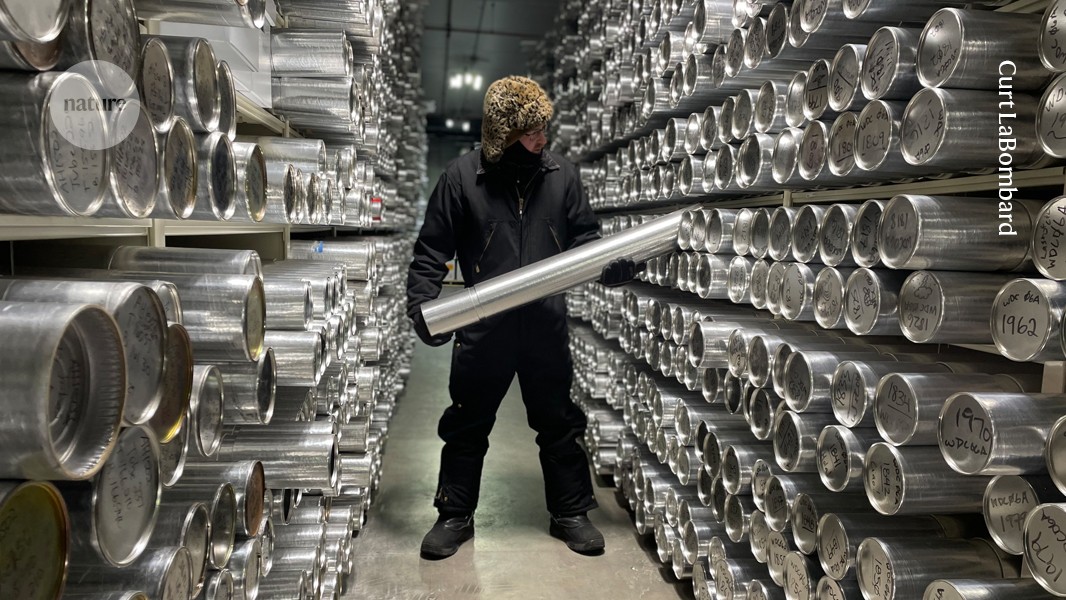Freezer holding world’s biggest ancient-ice archive to get ‘future-proofed’

Repository of samples drilled from glaciers and ice caps is replacing a coolant that can harm the ozone layer

Ice-core containers are stacked high at the US National Science Foundation Ice Core Facility in Denver, Colorado.Credit: Curt LaBombard
The world’s largest repository for ice cores is set to get an upgrade: its refrigeration system is switching from banned coolants that can harm the ozone layer to a more environmentally friendly technology.
“The ultimate replacement of refrigerants with ozone-friendly solutions is a very important, legally driven issue,” says Tas van Ommen, a climate scientist based in Hobart, Australia, who is the co-chair of the International Partnerships in Ice Core Sciences.
Celebrated ice
The US National Science Foundation Ice Core Facility (NSF-ICF) in Denver, Colorado, is host to some 25,000 metres of ice core, encompassing all cores drilled with NSF funding since the facility opened in 1993. This includes the core from the Vostok site in Antarctica1, which until the early 2000s held the record for being the oldest continuous ice, and new cores from Antarctica’s Allan Hills that contain the oldest ice ever retrieved, dating back millions of years. “They’re a hot commodity,” says Curt LaBombard, curator of the facility.
Such cores contain trapped air, particles and chemical isotopes that provide clues to past atmospheric composition and temperature, and about events such as volcanic eruptions. Extracted cores are typically sliced into sections, with some portions analysed by researchers and others kept in an archive for study at a later date.
The Denver archive’s 1,500-cubic-metre freezer is held at a chilly −36 ºC. Like many home refrigerators and air conditioning units built in the 1990s, it relies on a refrigerant called a hydrochlorofluorocarbon (HCFC).
Banned coolants
HCFCs that leak from production facilities or devices can deplete Earth’s protective ozone layer. So, like their even more destructive cousins the chlorofluorocarbons (CFCs), HCFCs are being phased out. The 1987 Montreal Protocol to save the ozone layer prohibited new HCFC production after 2020 in wealthy countries, and 2030 in poorer ones.
As a result, many newer fridges and air conditioners instead use hydrofluorocarbons (HFCs), which are much less problematic for ozone than HCFCs but can be potent greenhouse gases — up to 15,000 times as powerful as carbon dioxide. Two other large ice-core archive facilities, the Canadian Ice Core Lab at the University of Alberta in Edmonton and the European ice-core storage facility at the Alfred Wegener Institute in Bremerhaven, Germany, use HFCs.
But HFCs are also being phased out under a 2016 amendment to the Montreal Protocol, leaving chemists and companies hunting for “replacements for the replacements”, says Mark McLinden, who studies refrigerants at the US National Institute for Standards and Technology in Boulder, Colorado.
The phase-out rules apply to new devices, not existing ones, but LaBombard says the NSF facility’s operators felt the time had come for an upgrade anyway. The decades-old freezer is inefficient, its software obsolete and service and repair costs rising, says Michael Jackson, programme director for Antarctic Earth sciences at the NSF who is managing the refurbishment.
Future-proof coolant
Common options for replacement refrigerants that don’t harm ozone and are less powerful greenhouse gases include hydrofluoro-olefins, propane, ammonia and CO2. All have their pros and cons, including that some are toxic or flammable. Another large ice-core storage facility, in Japan, uses ammonia. The Denver facility managers chose ‘transcritical’ CO2, which can behave simultaneously as a liquid and a gas — an increasingly popular option for efficient commercial refrigeration. Jackson says that CO2, despite being a greenhouse gas, is non-flammable and “is more efficient at low operating temperatures”, adding that “it is difficult to quantify, but CO2 appears to be the most future-proof low-temperature refrigerant”.
Work on the new NSF freezer is scheduled to start this August and be completed in the first quarter of 2026.
A variety of universities keep their own ice cores in smaller cold-storage facilities. Some are watching with interest to see how the NSF-ICF refurbishment goes, because they might also need to change outdated refrigerants. “We’re in the same boat,” says Ellen Mosley-Thompson, a paleoclimatologist at the Ohio State University in Columbus. LaBombard says the Denver team is ready and willing to help others. “We’ve offered assistance and to share lessons learned,” he says.
doi: https://doi.org/10.1038/d41586-024-02287-8
This story originally appeared on: Nature - Author:Nicola Jones


















